Bullying continues to be an issue for anyone who attends or teaches school these days. Whether it comes in the form of a face-to-face encounter, a shunning campaign launched by classmates, or even through cyberspace, bullying often makes school classrooms an unsafe place for students. The National Center for Educational Statistics claims that during 2014, one in three students reported being bullied during the school year. Experts seem certain that bullying is unreported since victims often feel too embarrassed or fearful to report the incidents. The National Crime Victimization Survey of 2014 reports that of the bullying incidents that were reported, 65 per cent occurred twice in the year. Nineteen percent of those who reported incidents of bullying claimed the bullying occurred twice a month, and 7.8 percent reported bullying incidents occurred every day.
Obviously, bullying has negative effects on student health and school attendance. The Center for Disease Control reported that students who are bullied are twice as likely as their peers to suffer from depression, sleep difficulties, anxiety, and trouble adjusting to school. They are also twice as likely to get stomach aches and headaches. Readers may want to check out these and other reports and parent and teacher resources on bullying at the Nobullying.com. Additional book-related resources can be found on CJ Bott’s Bullies in Books website at or in her books, two excellent references for anyone wishing to explore bullying in their own classrooms: The Bully in the Book and in the Classroom (Scarecrow Press, 2004) and More Bullies in More Books (Scarecrow Press, 2009). Members of the Children’s Literature and Reading Special Interest Group remain concerned about the prevalence of bullying and suggest that books for children and teens offer one way to explore the issue. Consequently, this week’s book reviews focus on bullying as it is depicted in recent trade books.
Grades K-3
Bedford, David, (2014). Two Tough Crocs. Illus. by Tom Jellett. New York, NY: Holiday House.
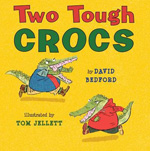 Tough as leather, Arnold and Sylvester are at the top of the pecking order when it comes to their watery neck of the woods. Passersby have learned to avoid the area since the two pick on anyone who passes their way and when they run out of potential victims, they even fight each other to determine crocodile supremacy. But their bullying days and ways cease when an even tougher female crocodile arrives on the scene. After putting them in their places, this tougher-than-tough bully ends up being frightened by what she imagines is after her. Despite her cruelty to them, Arnold and Sylvester manage to find some compassion for their former bully and lend a pair of helping hands. While there are certainly plenty of other books that deal with bullying, this picture book, first published in Australia, provides a good place to initiate a discussion with students. It also serves as an excellent reminder that since there is almost always someone bigger and tougher than you out there, being tough is never enough. A little heart and an act of kindness or two, even from a couple of tough crocs, never hurt anyone.
Tough as leather, Arnold and Sylvester are at the top of the pecking order when it comes to their watery neck of the woods. Passersby have learned to avoid the area since the two pick on anyone who passes their way and when they run out of potential victims, they even fight each other to determine crocodile supremacy. But their bullying days and ways cease when an even tougher female crocodile arrives on the scene. After putting them in their places, this tougher-than-tough bully ends up being frightened by what she imagines is after her. Despite her cruelty to them, Arnold and Sylvester manage to find some compassion for their former bully and lend a pair of helping hands. While there are certainly plenty of other books that deal with bullying, this picture book, first published in Australia, provides a good place to initiate a discussion with students. It also serves as an excellent reminder that since there is almost always someone bigger and tougher than you out there, being tough is never enough. A little heart and an act of kindness or two, even from a couple of tough crocs, never hurt anyone.
—Barbara A. Ward, Washington State University Pullman
Lynch, Jane. (2014). Marlene, Marlene, Queen of Mean. Illus. by Tricia Tusa. New York, NY: Random House Books for Young Readers.
 Marlene rules the halls of her school with a savage word and a piercing glance. And when those don’t work, she uses her height and size to intimidate others. Not one of her classmates feels safe whenever Marlene is around. She bullies them everywhere they go, on the playground, in class, and even on their way to the bathroom. There seems to be no place safe from Marlene. Told in rhyming text that is fun to read aloud, this story reveals the insecurities lie beneath this bully’s exterior. After Big Freddy stands up to Marlene and strips away her defenses, she has no choice but to start acting nicer to everyone around her. With its lively and cartoonish illustrations, this picture book offers a starting place for conversations about bullying behavior and some ways to cope with a bully, including standing up for oneself. Written by the actress who plays television series Glee’s bully, Sue Sylvester, this picture book is impressively filled with insights as well as being amusing.
Marlene rules the halls of her school with a savage word and a piercing glance. And when those don’t work, she uses her height and size to intimidate others. Not one of her classmates feels safe whenever Marlene is around. She bullies them everywhere they go, on the playground, in class, and even on their way to the bathroom. There seems to be no place safe from Marlene. Told in rhyming text that is fun to read aloud, this story reveals the insecurities lie beneath this bully’s exterior. After Big Freddy stands up to Marlene and strips away her defenses, she has no choice but to start acting nicer to everyone around her. With its lively and cartoonish illustrations, this picture book offers a starting place for conversations about bullying behavior and some ways to cope with a bully, including standing up for oneself. Written by the actress who plays television series Glee’s bully, Sue Sylvester, this picture book is impressively filled with insights as well as being amusing.
—Barbara A. Ward, Washington State University Pullman
Spagnol, Estelle Billon. (2014). Little Benguin. New York, NY: Holiday House.
 Little Benguin is not like any of the other animals in his community. With a rabbit and a penguin as his parents, his differences make it hard for him to fit in. After all, he doesn’t look like them. Not only do they make fun of him because he's different, but they shun him and won't even play with him. Little Benguin actually has high self-esteem and embraces his differences, but sometimes he feels very lonely and longs for companionship. When a wolf threatens him and the other animals, he uses his abilities as a penguin and as a rabbit to lead the wolf far from the others. Suddenly Benguin is a hero to them. It turns out that what makes him different also helps him survive, a good message for young readers as well as the rest of us.
Little Benguin is not like any of the other animals in his community. With a rabbit and a penguin as his parents, his differences make it hard for him to fit in. After all, he doesn’t look like them. Not only do they make fun of him because he's different, but they shun him and won't even play with him. Little Benguin actually has high self-esteem and embraces his differences, but sometimes he feels very lonely and longs for companionship. When a wolf threatens him and the other animals, he uses his abilities as a penguin and as a rabbit to lead the wolf far from the others. Suddenly Benguin is a hero to them. It turns out that what makes him different also helps him survive, a good message for young readers as well as the rest of us.
—Barbara A. Ward, Washington State University Pullman
Wells, Rosemary. Stella’s Starliner. Somerville, MA: Candlewick Press.
 This picture book gently reminds readers there is no place like home and that a home truly is where love resides. The size of a house has little relationship to what makes it a home for its inhabitants. Created with watercolor, gouache, pastel, ink, and colored pencil on sanded paper, the handsome illustrations and simple text make it clear Stella has a happy home. While her father works during the week, only returning for weekends, Stella and her mother share happy times in their silver trailer. Stella is blissful until some bullies, cruel weasels, make fun of her home. The author aptly describes those taunts as hurt "Stella's heart like the sting of bees" (unpaged). But when Stella finds some new friends in a new place, they regard her home quite differently, in a much more positive light. Not only is this picture book a marvelous example of the different perceptions of others, but it also shows how hurtful words can be. This picture book would be perfect for sharing with a class at the start of the year as a reminder not to judge others by where they live or their economic status.
This picture book gently reminds readers there is no place like home and that a home truly is where love resides. The size of a house has little relationship to what makes it a home for its inhabitants. Created with watercolor, gouache, pastel, ink, and colored pencil on sanded paper, the handsome illustrations and simple text make it clear Stella has a happy home. While her father works during the week, only returning for weekends, Stella and her mother share happy times in their silver trailer. Stella is blissful until some bullies, cruel weasels, make fun of her home. The author aptly describes those taunts as hurt "Stella's heart like the sting of bees" (unpaged). But when Stella finds some new friends in a new place, they regard her home quite differently, in a much more positive light. Not only is this picture book a marvelous example of the different perceptions of others, but it also shows how hurtful words can be. This picture book would be perfect for sharing with a class at the start of the year as a reminder not to judge others by where they live or their economic status.
—Barbara A. Ward, Washington State University Pullman
Grades 4-6
Egan, Kate. The Magic Shop Book 1: The Vanishing Coin. Illus. by Eric Wright. New York, NY: Macmillan/Feiwel & Friends.
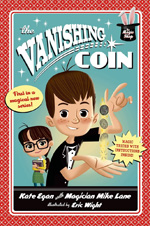 Mike's resolve to stay focused during his new fourth grade year isn't sticking too firmly. He keeps making mistakes and getting in trouble because he is easily distracted. But when he and his new neighbor Nora find a magic shop, Mike shows an affinity for various magic tricks. While he still finds it hard to remember his homework, being able to do the tricks and excel at something others with which others struggle boosts his self-esteem. Could the magic tricks he’s learning help Mike put Jackson, a classmate who enjoys picking on him and making fun of him, in his place? The inclusion of detailed how-to tips for the tricks Mike shows off to his classmates will fascinate budding magicians and elevate this one's appeal for fourth and fifth graders, many of whom will want to try the magic tricks for themselves. This is the start of a good series with a different hook through Mike’s talents as a budding magician.
Mike's resolve to stay focused during his new fourth grade year isn't sticking too firmly. He keeps making mistakes and getting in trouble because he is easily distracted. But when he and his new neighbor Nora find a magic shop, Mike shows an affinity for various magic tricks. While he still finds it hard to remember his homework, being able to do the tricks and excel at something others with which others struggle boosts his self-esteem. Could the magic tricks he’s learning help Mike put Jackson, a classmate who enjoys picking on him and making fun of him, in his place? The inclusion of detailed how-to tips for the tricks Mike shows off to his classmates will fascinate budding magicians and elevate this one's appeal for fourth and fifth graders, many of whom will want to try the magic tricks for themselves. This is the start of a good series with a different hook through Mike’s talents as a budding magician.
—Barbara A. Ward, Washington State University Pullman
Truesdale, Ann. How to Handle Cyberbullies. Illus. by Kathleen Petelinsek. North Mankato, MN: Cherry Lake Publishing.
 This slim but timely volume contains useful suggestions for how to deal with cyberbullying, whether you are a victim, a bystander or even the parent of one of these. Seeming to indicate that much cyberbullying occurs out of thoughtlessness, the book offers fairly generic reasons for this form of bullying that seems to be growing in prevalence, which might provide an opportunity for parents and teachers to discuss different types of bullying with youngsters. Often, it happens because there cyberspace seems to offer anonymity about anything that moves through its. The activities included in the book are useful since they are intended to make readers more mindful of the words they text, but this book is just a starting point. Readers will appreciate the fact that the author addresses how hard it is to avoid this kind of bullying since it follows its victims home where they should feel safe.
This slim but timely volume contains useful suggestions for how to deal with cyberbullying, whether you are a victim, a bystander or even the parent of one of these. Seeming to indicate that much cyberbullying occurs out of thoughtlessness, the book offers fairly generic reasons for this form of bullying that seems to be growing in prevalence, which might provide an opportunity for parents and teachers to discuss different types of bullying with youngsters. Often, it happens because there cyberspace seems to offer anonymity about anything that moves through its. The activities included in the book are useful since they are intended to make readers more mindful of the words they text, but this book is just a starting point. Readers will appreciate the fact that the author addresses how hard it is to avoid this kind of bullying since it follows its victims home where they should feel safe.
—Barbara A. Ward, Washington State University Pullman
Vail, Rachel. (2014). Justin Case: Rules, Tools, and Maybe a Bully. Illus. by Matthew Cordell. New York, NY: Macmillan/Feiwel and Friends.
 Fourth grader Justin Case is unsure about what fourth grade will be like or what his new teacher's expectations are. As he tries to put some of his anxieties behind him, he begins to make new friends and feel safe enough to take some risks. But he also realizes that one of his friends might be starting to become a bully, even focusing on Justin. As Justin tries to figure out what to do about Noah and whether he trusts Cash, a charismatic but bossy boy he met during summer camp, he faces some tough choices. This book effectively demonstrates how quickly someone can move from acceptance to being forgotten or even picked on as well as how feelings of insecurity arising from being left out can make someone want to lash out. Justin's ruminations on Noah's behavior and the way his classmates treat him when they think he is a tattletale are spot on, serving as great examples for classroom discussions. Written in a series of diary ruminations, the text with its accompanying illustrations portrays many of the perils of fourth grade. Many readers will relate to Justin's fears. After all, it seems as though each teacher has his/her own different set of rules and expectations, and it can be challenging to figure out what is expected, not to mention what’s going on with one’s classmates. Something that happened during the summer may have long-reaching effects in the fall.
Fourth grader Justin Case is unsure about what fourth grade will be like or what his new teacher's expectations are. As he tries to put some of his anxieties behind him, he begins to make new friends and feel safe enough to take some risks. But he also realizes that one of his friends might be starting to become a bully, even focusing on Justin. As Justin tries to figure out what to do about Noah and whether he trusts Cash, a charismatic but bossy boy he met during summer camp, he faces some tough choices. This book effectively demonstrates how quickly someone can move from acceptance to being forgotten or even picked on as well as how feelings of insecurity arising from being left out can make someone want to lash out. Justin's ruminations on Noah's behavior and the way his classmates treat him when they think he is a tattletale are spot on, serving as great examples for classroom discussions. Written in a series of diary ruminations, the text with its accompanying illustrations portrays many of the perils of fourth grade. Many readers will relate to Justin's fears. After all, it seems as though each teacher has his/her own different set of rules and expectations, and it can be challenging to figure out what is expected, not to mention what’s going on with one’s classmates. Something that happened during the summer may have long-reaching effects in the fall.
—Barbara A. Ward, Washington State University Pullman
Grades 7-8
Baskin, Nora Raleigh. (2014). Runt. New York, NY: Simon & Schuster Books for Young Readers.
 Relying on multiple voices, including canine, the author describes daily life in a typical middle school. Through the book’s various characters, some of the motivations for different sorts of name calling, bullying, teasing, and abuse occurring in a school setting are explored as well while providing some insight into bullies themselves and those being bullied or standing along the sidelines. In some cases, innocent acts become part of the cruel plots of others, and as the story moves toward its conclusion, readers can easily see that the characters have a great deal in common despite their differences. No one is perfect in this book, and even Elizabeth (dubbed Smelly-Girl since her mother boards dogs, which prompts some of her classmates to tease her about smelling like them) has her own cruel streak toward some of the dogs under her care, brought on by her own trials with her forgetful mother, her own arrogance, and her embarrassment. Part of the story takes place during a hurricane, which allows poisonous online messages to seep through the air for days while many are without electricity. Since the storm affects electricity and Internet access, Maggie, the girl who created a fake webpage denigrating “Smelly-Girl” has second thoughts about her actions, is unable to remove her cruel page until the power has been restored. Using several voices allows readers to gain multiple perspectives on this complex issue and gain insight into human behavior from the behavior of dogs and cats, it can be hard to distinguish each speaker or to come to know all the characters as well as might be desired. Despite the possible challenges of sorting all the characters' behaviors and motivations, there is much to consider here about the behavior of runts and top dogs in the animal kingdom, though.
Relying on multiple voices, including canine, the author describes daily life in a typical middle school. Through the book’s various characters, some of the motivations for different sorts of name calling, bullying, teasing, and abuse occurring in a school setting are explored as well while providing some insight into bullies themselves and those being bullied or standing along the sidelines. In some cases, innocent acts become part of the cruel plots of others, and as the story moves toward its conclusion, readers can easily see that the characters have a great deal in common despite their differences. No one is perfect in this book, and even Elizabeth (dubbed Smelly-Girl since her mother boards dogs, which prompts some of her classmates to tease her about smelling like them) has her own cruel streak toward some of the dogs under her care, brought on by her own trials with her forgetful mother, her own arrogance, and her embarrassment. Part of the story takes place during a hurricane, which allows poisonous online messages to seep through the air for days while many are without electricity. Since the storm affects electricity and Internet access, Maggie, the girl who created a fake webpage denigrating “Smelly-Girl” has second thoughts about her actions, is unable to remove her cruel page until the power has been restored. Using several voices allows readers to gain multiple perspectives on this complex issue and gain insight into human behavior from the behavior of dogs and cats, it can be hard to distinguish each speaker or to come to know all the characters as well as might be desired. Despite the possible challenges of sorting all the characters' behaviors and motivations, there is much to consider here about the behavior of runts and top dogs in the animal kingdom, though.
—Barbara A. Ward, Washington State University Pullman
Blackstone, Matt. (2014). Sorry You’re Lost. New York, NY: Farrar, Straus and Giroux.
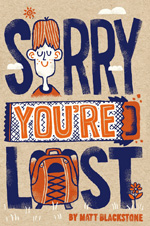 Scratch below the surface of a bully’s skin, and there are usually hidden fears or insecurities. In the case of seventh grader Denny (Donuts) Murphy, becoming the class clown and making fun of others is his way of coping with loss. He even pretends to talk to his deceased mother on his phone. But his increasingly bizarre behavior causes his teachers to become concerned. Denny rarely shows up for class, and when he does attend class, he misbehaves and tries to entertain his classmates. The author describes vividly the distance that has grown between Denny and his father, brought out into the open during a parent/teacher conference. The book's honesty and its humor will appeal to middle grade readers as well as prospective middle school teachers since it offers insight into the behavior of many students in those grades and offers explanations for some of their inappropriate behavior. Clearly, losing someone can also mean losing parts of oneself.
Scratch below the surface of a bully’s skin, and there are usually hidden fears or insecurities. In the case of seventh grader Denny (Donuts) Murphy, becoming the class clown and making fun of others is his way of coping with loss. He even pretends to talk to his deceased mother on his phone. But his increasingly bizarre behavior causes his teachers to become concerned. Denny rarely shows up for class, and when he does attend class, he misbehaves and tries to entertain his classmates. The author describes vividly the distance that has grown between Denny and his father, brought out into the open during a parent/teacher conference. The book's honesty and its humor will appeal to middle grade readers as well as prospective middle school teachers since it offers insight into the behavior of many students in those grades and offers explanations for some of their inappropriate behavior. Clearly, losing someone can also mean losing parts of oneself.
—Barbara A. Ward, Washington State University Pullman
French, Simon. (2014). My Cousin’s Keeper. Somerville, MA: Candlewick Press.
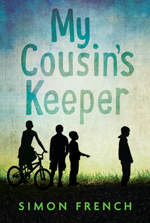 This moving story, originally published in Australia, provides insight into the desperate acts necessitated by trying to fit in. After his best friend moves away, 11-year-old Kieran isn’t sure with which social group he belongs at his school. His insecurity makes him feel disturbingly at sea when it comes to his social standing, and as a result of that insecurity, he's willing to behave in ways that aren't typical of him. A case in point involves his cousin Bon. Being the new kid in class and wearing his hair in a long braid mark him as different from his classmates. Instead of being his cousin’s protector against the bullies, Kieran gladly sacrifices his familial allegiance to the cousin he resents for a bid at acceptance from cool kid Mason and his set. The bullying starts slowly and escalates, of course, and were it not for Julia, another new classmate on whom Kieran has a small crush, who knows what might have happened? Julia bravely intervenes against Mason’s bullying of Bon with little consideration of the consequences for her own social standing. Not only that, but she holds Kieran accountable for better behavior. Tackling bullying’s complexity honestly as well as examining family dynamics, this book offers plenty of material for class discussion while reminding readers to embrace their better sides. Bon's story is heart-breaking in many ways, in part, because he has had little control over his upbringing. No wonder he writes and draws an imaginary world where he, Julia, and Kieran are heroic figures. This one will cause readers to consider how often they stand up or remain silent when others have been singled out for ridicule.
This moving story, originally published in Australia, provides insight into the desperate acts necessitated by trying to fit in. After his best friend moves away, 11-year-old Kieran isn’t sure with which social group he belongs at his school. His insecurity makes him feel disturbingly at sea when it comes to his social standing, and as a result of that insecurity, he's willing to behave in ways that aren't typical of him. A case in point involves his cousin Bon. Being the new kid in class and wearing his hair in a long braid mark him as different from his classmates. Instead of being his cousin’s protector against the bullies, Kieran gladly sacrifices his familial allegiance to the cousin he resents for a bid at acceptance from cool kid Mason and his set. The bullying starts slowly and escalates, of course, and were it not for Julia, another new classmate on whom Kieran has a small crush, who knows what might have happened? Julia bravely intervenes against Mason’s bullying of Bon with little consideration of the consequences for her own social standing. Not only that, but she holds Kieran accountable for better behavior. Tackling bullying’s complexity honestly as well as examining family dynamics, this book offers plenty of material for class discussion while reminding readers to embrace their better sides. Bon's story is heart-breaking in many ways, in part, because he has had little control over his upbringing. No wonder he writes and draws an imaginary world where he, Julia, and Kieran are heroic figures. This one will cause readers to consider how often they stand up or remain silent when others have been singled out for ridicule.
—Barbara A. Ward, Washington State University Pullman
Grades 9-12
Feinstein, John. (2014). The Triple Threat: The Walk On. New York, NY: Knopf Books for Young Readers.
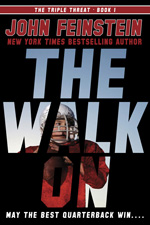 Freshman Alex Myers has a throwing arm so accurate that his teammates dub him Goldie. When his parents split up, his mother moves him and his sister to Philadelphia, and he must prove himself on the football playing field. Although he is clearly talented, the QB job belongs to junior Matt Gordon, the coach's son, and Alex has little chance to take his spot. As the team makes its way to the state playoffs, Alex finally gets his chance, but he and the coach have a stormy relationship. In addition to the detailed passages of play on the gridiron, readers will like how nice Alex’s rival Matt actually is. Even though he has it made, he still goes out of his way to be welcoming to the new kid on the block. The author nails the unsavory side of athletics perfectly with passages concerning the coach's behavior, expectations, and the way he bullies those around him. All too often his behavior is typical of how some coaches think they need to behave in order to lead a winning team. The inclusion of the battle between the press and the subjects being covered was interesting too, but it seems unlikely that any of the football players would talk to reporters. Usually, groups maintain solidarity, which can allow unethical things to occur. Since this is part of a trilogy, readers will eagerly follow Alex's excursions into two other sports and wonder whether his own father follows up on his promises to be more involved in Alex’s life. Football fans will devour this one even while recognizing the pressure to conform to an adult’s expectations even when those can lead to problems. Sometimes adults are not the role models others would like them to be.
Freshman Alex Myers has a throwing arm so accurate that his teammates dub him Goldie. When his parents split up, his mother moves him and his sister to Philadelphia, and he must prove himself on the football playing field. Although he is clearly talented, the QB job belongs to junior Matt Gordon, the coach's son, and Alex has little chance to take his spot. As the team makes its way to the state playoffs, Alex finally gets his chance, but he and the coach have a stormy relationship. In addition to the detailed passages of play on the gridiron, readers will like how nice Alex’s rival Matt actually is. Even though he has it made, he still goes out of his way to be welcoming to the new kid on the block. The author nails the unsavory side of athletics perfectly with passages concerning the coach's behavior, expectations, and the way he bullies those around him. All too often his behavior is typical of how some coaches think they need to behave in order to lead a winning team. The inclusion of the battle between the press and the subjects being covered was interesting too, but it seems unlikely that any of the football players would talk to reporters. Usually, groups maintain solidarity, which can allow unethical things to occur. Since this is part of a trilogy, readers will eagerly follow Alex's excursions into two other sports and wonder whether his own father follows up on his promises to be more involved in Alex’s life. Football fans will devour this one even while recognizing the pressure to conform to an adult’s expectations even when those can lead to problems. Sometimes adults are not the role models others would like them to be.
—Barbara A. Ward, Washington State University Pullman
Wolf Kam, Jennifer. (2014). Devon Rhodes is Dead. Watertown, MA: Mackinac Island Press.
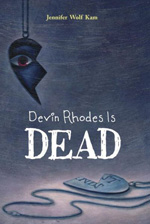 Police are puzzled when 15-year-old Devon Rhodes is found dead in a ravine near town, and her best friend Cass Kirschner ruminates upon the role she played in her death. The author keeps readers guessing by alternating “Before” and “After” chapters and hinting at possible reasons for her death. While it's clear Cass is guilty of something, it isn’t so clear where her guilt lies. Young teen readers will race to the book's conclusion to find out what led to Devon's demise. Slowly, incident by incident, the author describes just how bad a friend Devon was to Cass in real life. Clearly, she was selfish, self-absorbed, and thoughtless when it came to Cass. In fact, she bullied Cass and their former friends into doing whatever she wanted, something that actually leads to her death. As she watches Devon engage in increasingly risky behavior, Cass wishes she were free from this one-sided friendship. While the ending is a bit abrupt, the book will keep readers engaged as they try to figure out where to place the blame. Young teen readers may enjoy examining the bullying behavior of someone who is supposed to be a friend but rarely acts like one and then considering their own friends and their behavior toward them.
Police are puzzled when 15-year-old Devon Rhodes is found dead in a ravine near town, and her best friend Cass Kirschner ruminates upon the role she played in her death. The author keeps readers guessing by alternating “Before” and “After” chapters and hinting at possible reasons for her death. While it's clear Cass is guilty of something, it isn’t so clear where her guilt lies. Young teen readers will race to the book's conclusion to find out what led to Devon's demise. Slowly, incident by incident, the author describes just how bad a friend Devon was to Cass in real life. Clearly, she was selfish, self-absorbed, and thoughtless when it came to Cass. In fact, she bullied Cass and their former friends into doing whatever she wanted, something that actually leads to her death. As she watches Devon engage in increasingly risky behavior, Cass wishes she were free from this one-sided friendship. While the ending is a bit abrupt, the book will keep readers engaged as they try to figure out where to place the blame. Young teen readers may enjoy examining the bullying behavior of someone who is supposed to be a friend but rarely acts like one and then considering their own friends and their behavior toward them.
—Barbara A. Ward. Washington State University Pullman
Wood, Fiona. (2014). Wildlife. New York, NY: Little, Brown: Poppy.
 Sixteen-year-old Sibylla Quinn heads on a semester-long school trip in the wilderness with several classmates, including her best friend Holly. Sib has never had a boyfriend, and Holly decides to coach her on her relationship with school golden boy, Ben. But Holly is not to be trusted, and readers will have twinges about her dastardly nature almost from the first. While Sib is easy-going and has learned to deal with Holly's personality and need to be the center of things, Lou, another girl on the trip, quickly sizes Holly up as a subtle bully and manipulator who is jealous of her best friend. While Lou continues to mourn the loss of her boyfriend Fred, she finds herself drawn into all the relationship drama. After things heat up between Sib and Ben and she decides to have sex, she also has second thoughts and decides to slow things down. The author describes perfectly how Sib almost loses herself as she allows her need to please Ben and fit in with his crowd as well as placate Holly keeps her from standing up for herself and her beliefs. Well-written, honest, and deeply engaging, this book will make readers care about both Lou and Sib and despise Holly and her machinations. It’s clear Holly’s friendship is the kind Sib can do without and bullies come in all sorts of shapes, sizes, and forms.
Sixteen-year-old Sibylla Quinn heads on a semester-long school trip in the wilderness with several classmates, including her best friend Holly. Sib has never had a boyfriend, and Holly decides to coach her on her relationship with school golden boy, Ben. But Holly is not to be trusted, and readers will have twinges about her dastardly nature almost from the first. While Sib is easy-going and has learned to deal with Holly's personality and need to be the center of things, Lou, another girl on the trip, quickly sizes Holly up as a subtle bully and manipulator who is jealous of her best friend. While Lou continues to mourn the loss of her boyfriend Fred, she finds herself drawn into all the relationship drama. After things heat up between Sib and Ben and she decides to have sex, she also has second thoughts and decides to slow things down. The author describes perfectly how Sib almost loses herself as she allows her need to please Ben and fit in with his crowd as well as placate Holly keeps her from standing up for herself and her beliefs. Well-written, honest, and deeply engaging, this book will make readers care about both Lou and Sib and despise Holly and her machinations. It’s clear Holly’s friendship is the kind Sib can do without and bullies come in all sorts of shapes, sizes, and forms.
—Barbara A. Ward, Washington State University Pullman
These reviews are submitted by members of the International Reading Association's Children's Literature and Reading Special Interest Group (CL/R SIG) and are published weekly on Reading Today Online.